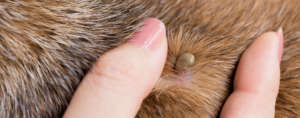The distribution of ticks is changing due to factors like climate change, deforestation, and the evolving patterns of deer, birds, and rodents in terms of their habitats and migrations. These changes can vary annually or even seasonally. Ticks can be found in almost all parts of the United States, including urban areas, as well as many other regions worldwide. They present a danger to both humans and pets.
Several significant tick-borne diseases affect dogs, including Lyme disease, Ehrlichiosis, Anaplasmosis, Rocky Mountain Spotted Fever, Babesiosis, Bartonellosis, and Hepatozoonosis. All of these diseases can have severe health consequences for dogs, and many of them can also affect humans.
Lyme Disease
 Lyme disease is an infectious illness caused by the Borrelia bacteria, which is carried by the Black-Legged Tick, commonly known as the Deer Tick. Initially associated with the Northeast and upper Midwest regions of the United States, Lyme disease is now being observed on the West Coast (Washington, Oregon, and California) and in Florida. In fact, Lyme disease has been detected in dogs across various parts of the country and even in certain areas of southern Canada. For the transmission of the bacteria to occur, the tick must remain attached to its host for about 36-48 hours, and signs of illness typically manifest around 2-5 months after the tick bite.
Lyme disease is an infectious illness caused by the Borrelia bacteria, which is carried by the Black-Legged Tick, commonly known as the Deer Tick. Initially associated with the Northeast and upper Midwest regions of the United States, Lyme disease is now being observed on the West Coast (Washington, Oregon, and California) and in Florida. In fact, Lyme disease has been detected in dogs across various parts of the country and even in certain areas of southern Canada. For the transmission of the bacteria to occur, the tick must remain attached to its host for about 36-48 hours, and signs of illness typically manifest around 2-5 months after the tick bite.
It is essential to thoroughly check for ticks and promptly remove them after walking in wooded areas or other grassy or shaded locations where ticks are likely to reside. In urban areas, this might include local dog parks.
Signs of Lyme disease in dogs may include fever, lameness, limping, joint pain or swelling, enlarged lymph nodes, and lethargy. Lyme disease can progress to kidney disease, which can be fatal. Unlike in humans, dogs do not develop a “bull’s eye” rash.
The diagnosis of Lyme disease in dogs is usually done through blood tests. The initial test detects exposure to the tick-borne agent and assists the veterinarian in determining the need for additional testing.
The treatment of a dog that tests positive on the initial test but is otherwise healthy remains a topic of controversy among some veterinarians. When the decision to treat a dog with Lyme disease is made, antibiotics are typically prescribed for a duration of 28-30 days.
A vaccine is available for Lyme disease, along with various tick preventatives. While the duration and effectiveness of the vaccine are questioned by some, it may reduce the rate and severity of the illness if it does appear. Dog owners should consult their veterinarian to determine if the vaccine is appropriate for their pet.
Canine Ehrlichiosis
Canine Ehrlichiosis is a disease found worldwide. It is caused by several types of ticks, including the Brown Dog Tick, Lone Star Tick, and American Dog Tick. Signs of the disease include fever, poor appetite, and low blood platelets, often leading to nosebleeds, bruising, or anemia. Symptoms typically appear 1-3 weeks after an infected tick bite. Dogs that are diagnosed and treated promptly have a good prognosis, while those that enter the chronic phase of the disease face more challenges in recovery.
Anaplasma
Anaplasma is a disease caused by a bacterium carried by the Black-Legged Tick (Ixodes). While Anaplasma can be found worldwide, two specific Anaplasma species are known to cause disease in dogs in North America:
Phagocytophilum: prevalent in the Northeast and upper Midwestern United States.
Platys: found in California and coastal states.
The signs of Anaplasma are similar to those of Lyme disease, although dogs with Anaplasma often experience low blood platelet levels leading to bleeding disorders.
Rocky Mountain Spotted Fever
Rocky Mountain spotted fever is one of the more well-known tick-borne diseases affecting both dogs and humans. It is transmitted by the American Dog Tick, the Rocky Mountain Wood Tick, and the Brown Deer Tick. This disease has been identified in various parts of North, South, and Central America. Signs of the disease include fever, decreased appetite, swollen lymph nodes, joint pain, and sometimes neurological symptoms such as wobbliness.
Babesiosis
Babesiosis primarily results from tick bites, but it can also be transmitted through dog bites, transplacental transmission, and potentially contaminated IV blood. The main concern associated with Babesiosis is the breakdown of red blood cells, known as “hemolysis.” Symptoms include lethargy, pale gums, dark-colored urine, and jaundice (yellow/orange-colored skin or the whites of the eyes).
Bartonella
Bartonella is an emerging infectious disease in dogs, cats, and humans. It is also known as cat scratch disease (CSD). Most infections occur after scratches from domestic or feral cats that have been infected by fleas. CSD can occur wherever cats and fleas are found.
Hepatozoonosis
Hepatozoonosis differs slightly, as the infection occurs when a dog ingests an infected tick. This disease is not zoonotic, meaning it cannot be transmitted to humans from infected dogs. It is generally found in the southern United States. Signs of the disease include pain, reluctance to stand or move, fever, muscle wasting, and mild to moderate anemia. Hepatozoonosis is a severely debilitating disease that often leads to fatality.
How To Prevent Tick-Borne Disease
Tick-borne diseases can pose a significant risk to the health of dogs and humans. It is crucial for dog owners to have a discussion with their veterinarian to determine the most effective approach for flea and tick control.
For additional information, you can visit the American Kennel Club’s Canine Health Foundation.
A comprehensive map displaying the prevalence of Lyme disease can be found on the Center for Disease Control website.


